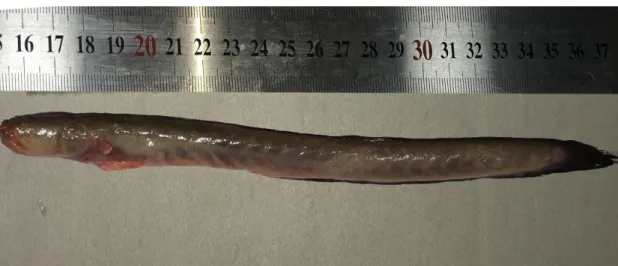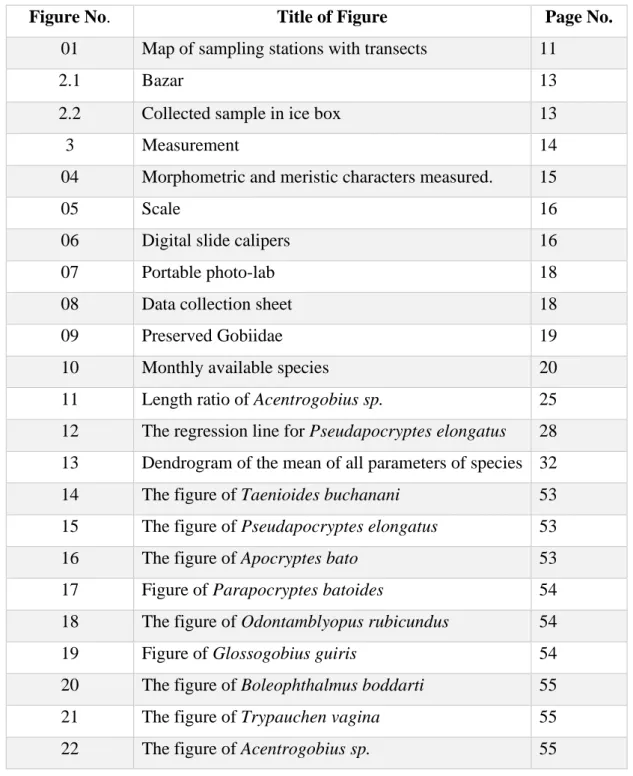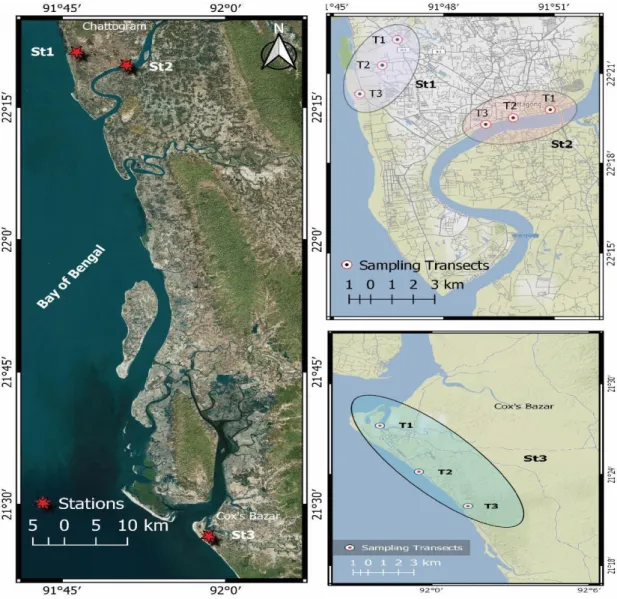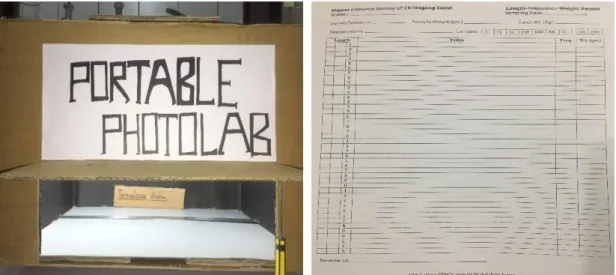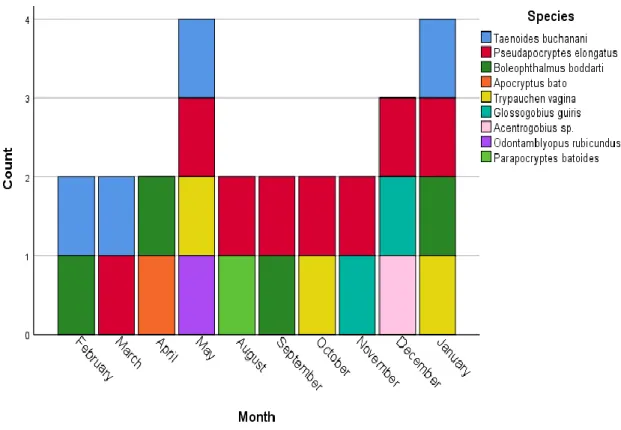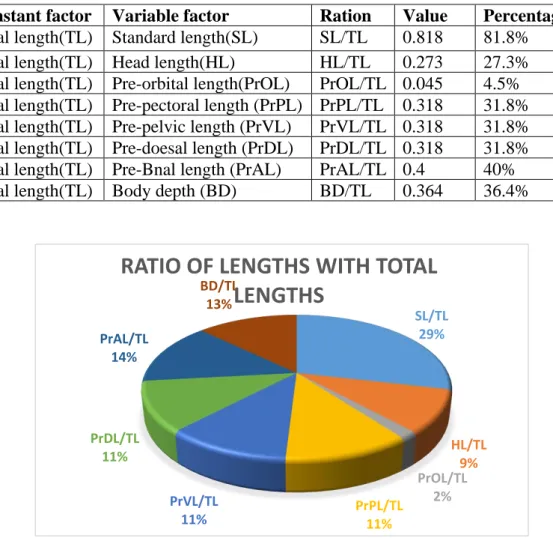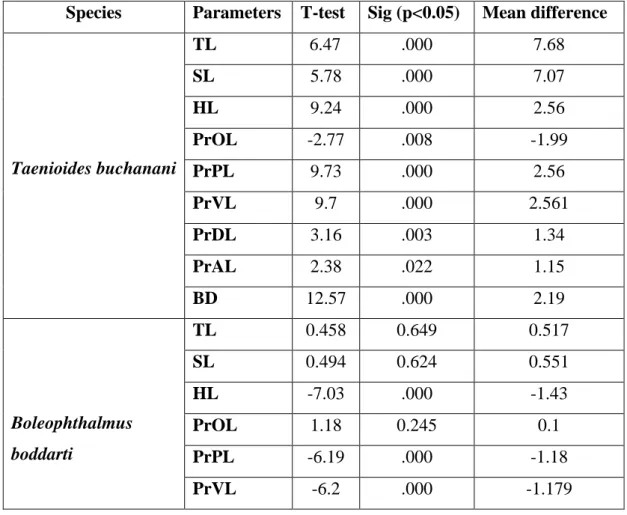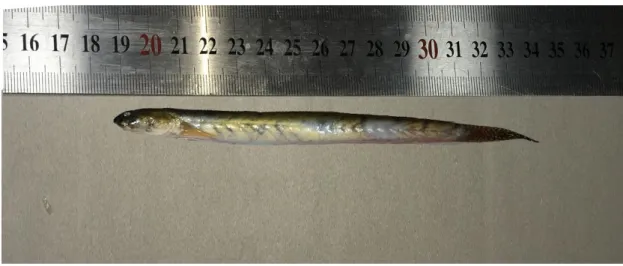Mohammad Alamgir Hossain, Professor, Department of Pathology and Parasitology, CVASU, for his valuable supervision and guidance. It is a pleasure to convey my gratitude to my co-supervisor, Mr. Sk. Istiaque Ahmed, Assistant Professor, Department of Fisheries Resource Management, CVASU, for his valuable advice and educational guidance. 04 Correlation table for Taenioides buchanani 21 05 Correlation table for Pseudapocryptes elongates 22 06 Correlation table for Apocryptes bato 22 07 Correlation table for Parapocryptes batoides 23 08 Correlation table for Odontamblyopus rubicundus 23 09 Correlation table for Glossogobius guisris 24 10 Length percentage table for A centrog obius sp.
25 11 Correlation table for Boleophthalamyus boddarti 25 12 Correlation table for Trypauchen vagina 26 13 Table for T-test between species group 29-31 14 Table for meristic counting for all available species 33. IV Regression table for Parapocryptes batoides 51 V Regression table for Odontamblyopus rubicundus 51 VI Regression table for Glossogobius guiris 51-52 VII Regression table for Boleophthalamyus boddarti 52 VIII Regression table for Trypauchen vagina 52.
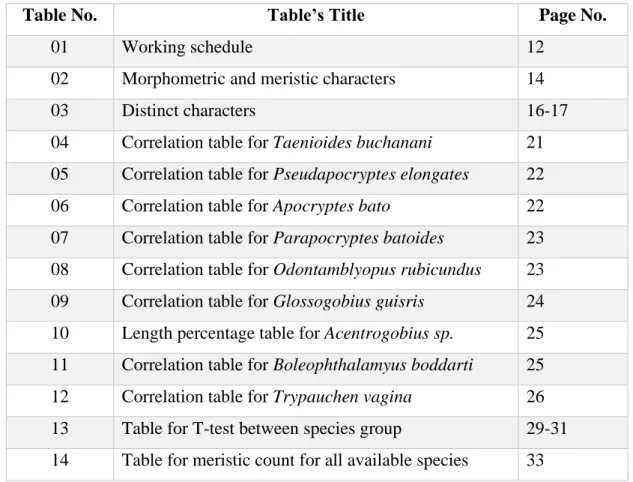
ABSTRACT
INTRODUCTION
- Background study
- Significance of study
- Importance of morphology
- Importance of Chattogram coast
- Status of Gobiidae in Bangladesh
- Objectives of the Study
Another application of morphological and meristic characteristics in aquaculture is the measurement of hormone treatment (Yanong et al., 2010). The most important purpose of morphometric and meristic characters is fish identification. The fish family Gobiidae is one of the largest families among 2000 species under 270 genera (Patzner et al., 2011).
Boleophthalmus dussumeiri provides 0.40 g of carbohydrates against the consumption of 100 g of the liver (Kanejiya et al., 2017). To identify the morphometric and meristic differences among the available fishes among the Gobiidae family along the Chattogram coast.
REVIEW OF LITERATURE
Studies were done in Bangladesh (Associated with the Gobiidae family)
A comparative study on the conceptual idea of morphometric and meristic characteristics was done in the study may open a further opportunity to identify Gobiidae fishes in other available Gobiidae of Bangladesh. A survey type study on the availability of fishes of the greater Noakhali region examined the available Gobiidae fishes of the Noakhali region (Hossain, 2013). The stage, state of availability and other basic characteristics associated with these species were also studied in the survey.
The stock of haor has been shown to be different in the case of a transverse scale on the lateral line. In the study, Glossogobius guiris lengths were found to be correlated with total length (LT), except eye length (LE), snout length (LSN) and mouth gape (MG).
Associated Gobiidae family studies (International boundary aspect)
The results of the study are the variety of characters in which the population differed from each other. Significant differences at 5% level of significance were also found in case of some meristic characters including lateral line scale (LLS), caudal fin ray (CR), pectoral fin ray (PR) and anal fin ray (AR). The three groups of morphometric truss data consist of Kuala Selangor and Banting populations in the first group, Melaka and Port Dickson populations in the second group, and Pulau Pinang populations in the third group.
At the border of the northern part of Malaysia, mudskippers were distantly distinguished from the species of the middle and southern regions. The authors established a relationship between height and weight reported in the Boleophthalmus boddarti study: logW = log log TL.
Morphometric studies of other fishes
Page | 9 character data were analyzed within and between populations and a significant difference of less than 5% significance was found. Nevertheless, it has also been hypothesized that this variation may be due to environmental influences (trait plasticity) rather than genetic variation. 2014) carried out morphometric and meristic analysis with a view to race investigation of Coilla ramcarati from Chattogram and Cox's Bazar coast. Morphometric measurements and meristic counts of Coilia ramcarati were statistically analyzed in the study to determine the certainty of any racial difference in the species from the Chittagong and Cox's Bazar coasts of the Bay of Bengal.
Some variations were found, which were insignificant at 5% significance level, indicating that the populations of Coilia ramcarati on the coasts of Chittagong and Cox's Bazar were not racially distinct.
MATERIALS AND METHODS
- Sampling Area
- Working schedule –
- Sampling strategy
- RESULT
- Taenioides buchanani
- Pseudapocryptes elongates
- Glossogobius guiris
- Acentrogobius sp
Three related measures categorized into small, medium and large available sample sizes were sampled to represent the population and avoid bias. Total length (TL)= The length of the fish in centimeters from the starting point of the mouth to the last point of the tail. Standard Length (SL)= The length of the fish in centimeters from the top of the head to the caudal peduncle.
Head Length (HL)= Length of the fish in centimeters from the very first point of the head to the end of the operculum. Pre-orbital length (PrOL) = Length of the fish in centimeters from the very first point of the head to the beginning of the eye rim. Pre-pectoral Length (PrPL)= Length of the fish in centimeters from the very first point of the head to the beginning of the pectoral fin base.
Pre-pelvic length (PrVL)= Length of the fish in centimeters from the very first point of the head to the beginning of the pelvic fin base. Pre-dorsal length (PrDL) = Length of the fish in centimeters from the very first point of the head to the beginning of the dorsal fin base. Pre-anal length (PrAL) = Length of the fish in centimeters from the first point of the head to the base of the anal fin.
Blackish stripes form an angular shape against the straight back profile of the body, and the frequency is 10. The result part of the analysis summarizes the result of the performance of the study interest. Since the analysis was almost exclusively based on the morphological and meristic characteristics of the available Gobiidae fishes of the Chattogram coast, so the main emphasis was placed on the manual morphological analysis to collect data and to make further analyses.
From the study and the entire research process, a total of 8 species and one genus of Gobiidae were reported from Chattogram coast. The species available per month were derived from the data representing that month: May and January were the months showing the highest species availability, and Pseudapocryptes elongatus was the highest in availability of Gobiidae species on the Chattogram coast among the stations.
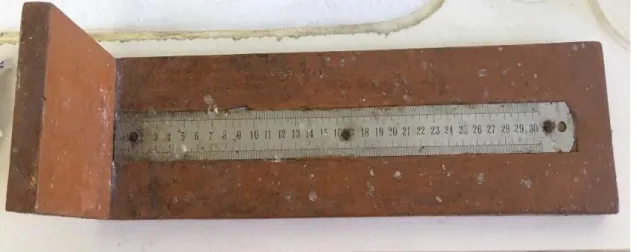
RATIO OF LENGTHS WITH TOTAL LENGTHS
Meristic counts
To establish finning formula, which was the basic logical way to find out any species, all data of meristic counts were collected. Here, meristic counts of species were collected in a mapped form to quickly interpret the characters of the fish.
DISCUSSION
Glossogobius guiris had six rays on the first dorsal fin and 9-11 fin rays on the second dorsal fin, which were considered the most important identifying features of this species in freshwater stocks, especially in pond stocks. According to the same experiment, but in a different species, the species revealed that it had six rays on the first dorsal fin, ten rays on the second dorsal fin, 20-21 rays on the pectoral fin, ten pelvic fin rays, and 14-16 rays. rays on the anal fin together with 30-32 scales on the lateral line. Another file documented that the estuary species possessed six rays on the first dorsal fin and 9-10 rays on the second dorsal fin, as well as 17-21 rays on the pectoral fin, ten rays on the pelvic fin, 8-9 rays on the anal fin . fin and 16-18 rays on the caudal fin with 29-31 scales on the lateral line.
According to the present experiment, G. guiris had six spines on the first dorsal fin and one spine and nine soft rays on the second dorsal fin. The Glossogobius guiris species of the present study also have 18-19 soft rays on the pectoral fin, nine soft rays on the pelvic fin, one spine and ten soft rays on the anal fin and 12-14 rays on the caudal fin possessing 30-32 scales on the sideline. Page | 38 In the scales on the lateral line, however, it showed similarities with the haor stock.
In the case of lateral scale and all differences, it may occur due to environmental influences or genetic divergence. 2013) experimented with the PG dose effect on both separated male and female groups of G. guiris, but in this process the authors went through the morphological analysis to observe the growth. These differences occurred for the geological distance and environmental factors experimented on the sample of Kaila beel from Ishwarganj, Mymensingh, the freshwater influenced northern part of Bangladesh.
The study focused mainly on the distribution, ecological and biological features of the species. The experiment focused on the difference between the two species and the male-female groups within the species in both cases. In addition, there was a common species, Glossogobius guiris as Mahilum et al. 2013) focused on the male and female group within the species correlation), and all similarities indicated to be the same species of different geological locations.
CONCLUSION
RECOMMANDATION
Morphometric relationships of the tank goby Glossogobius giuris (Hamilton, 1822) in the Gorai River using multi-linear dimensions. Distribution, biological and ecological characteristics of the foreign species Pomatoschistus bathi Miller, 1982 (Gobiidae) in the Black Sea. Morphological variations of the white goby (Glossogobius giuris Hamilton 1822, Teleostei: Gobiidae) in three lakes of Southern Luzon, Philippines.
Fish of India; being a natural history of the fishes known to inhabit the seas and fresh waters of India, Burma, and Ceylon. Gobiodon brochus: a new species of gobiid fish (Teleostei: Gobioidei) from the western South Pacific, with a description of its unique jaw morphology. Morphological distinctness among three isolated river populations of the Tank Goby (Gobiidae: Glossogobius giuris Hamilton, 1822) Based on truss network analysis.
Fishes of the family Gobiidae recorded from rivers and estuaries in Bangladesh: morphometric and meristic studies. Morphological variations of Labeo bata populations (Teleostei: . Cyprinidae) in six rivers of Bangladesh: a landmark-morphometric contribution. Morphological variations of Labeo bata populations (Teleostei: Cyprinidae) in six rivers of Bangladesh: a landmark-morphometric contribution.
Interspecific variation in acoustic signals in Mediterranean gobies (Perciformes, Gobiidae): a comparative analysis and an evolutionary perspective. Characteristics of the identified morphology of the genus Acentrogobius bleeker, 1874 in the estuary and coastal part of Nghe An province, Vietnam. Morphometric and meristic analysis of Coilia ramcarati (Hamilton, 1822) for racial investigation from Chittagong and Cox s Bazar coasts.
